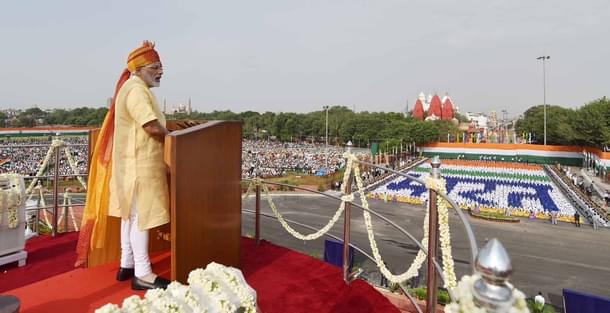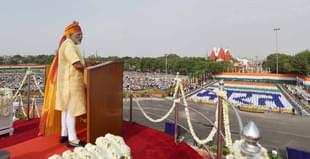Politics
How To Read Modi’s Independence Day Speech And What It Tells Us About Plans For 2019
R Jagannathan
Aug 15, 2017, 11:34 AM | Updated 11:34 AM IST
Save & read from anywhere!
Bookmark stories for easy access on any device or the Swarajya app.


Narendra Modi’s fourth Independence Day speech – the penultimate one before the Lok Sabha elections of 2019 – marks a shift in the formulation and tone of his communication with the nation. If the first speech in 2014 was inspirational and loaded with good intentions, and the next two were about making announcements and taking forward the agenda of change, this one was about resetting expectations and focusing the electorate on what has been done, and what to expect in the next two years.
If, in the run-up to 2014 and his first year in office, we saw Modi focus attention on delivering on the promise of achche din, this time the effort was to provide realistic markers for what this could mean, and offer the right metrics for measuring achche din. He has also subtly moved the end-date for its achievement to 2022 – the 75th year of independence – and conveniently after the next general elections. The slogan is not bijli, sadak, paani, but pucca ghar, bijli, paani, with the sadak part now rapidly becoming a reality in most states.
What was noteworthy in the speech, which was forceful and clear, was its reversion to his central 2014 slogan of sabka saath, sabka vikas. Barring one reference to his support for women who are fighting against triple talaq, there was no effort to bung in controversial issues, whether in terms of domestic or foreign policy.
He did not avoid difficult issues where the government may be on the backfoot, but he slipped them in gently. There was some degree of acknowledgement of the Gorakhpur tragedy where more than 60 babies died due to medical neglect and official callousness, the flood havoc in various parts of the country, and even an indirect acceptance that demonetisation may not have achieved big success where it was expected to. So, he subtly moved the goalposts from the trapping of black money holders to getting them to pay up taxes, now that their money is parked inside the banking system.
This is smart politics. Not everything politicians promise or try to achieve necessarily get achieved in a complex ecosystem like India, with its entrenched corruption and back-door approach to getting things done. So, the best thing politicians can do is to try something new, and based on what you actually achieve, shift the focus to the points of change, rather than the original stated goals.
Discernible in the speech was an effort to revert to statesmanship and position the PM as someone above the battle, while at the same time offering subtle cues to the voter on how she should judge his tenure when heading for the ballot box in 2019.
We saw Modi using all the right phrases and catchwords while envisioning a New India (divya, bhavya Bharat), while shifting the focus from swaraj to suraaj, from Bharat chodo to Bharat jodo, from a chalta hai attitude to one where we can believe that desh badal sakta hai, and calling an end to communalism and casteism. This was a harkback to the political correctness of most of Modi’s speeches.
But if you really want a cue on what could form the centrepiece of his electoral communication strategy between now and 2019, it is not jobs or a booming economy, but his drive against corruption and black money. He talked at length on notebandi, the fight against benami properties, the bringing in (post-demonetisation) of over Rs 3 lakh crore of (black?) money into the banking system, the expansion of the tax base, the campaign against shell companies (presumably run by crooked promoters), etc. The goods and services tax (GST) was pitched as part of this effort to get people to pay tax.
This makes it clear that even though demonetisation did not deliver on its short-term economic goals, it may still deliver on its political messaging – which is about positioning Modi as the scourge of black money and corruption.
This is the one tangible point on which few voters may dispute Modi’s claims, and one can be sure it will be a central plank in his campaign rhetoric. More important, by making the fight against corruption the centrepiece of his re-election campaign, he can also appeal for patience. Everyone understands that corruption is deep-rooted. So, the fight will take time. This is an argument most people will buy, as the patient crowds waiting outside banks to exchange their old notes demonstrated.
The undertone of his messaging is this: change in happening, even if it seems slow. So, have patience. We are on the right track. So please strengthen my hands, so that your fight in not abandoned in 2019.
On jobs, which is a major challenge for Modi, his effort will be to shift the goalposts, by emphasising what is being done (skilling and about promotion of self-employment). Hence he talked about Mudra loans making it possible for the poor to create their own employment, and, in the process, the poor becoming micro job creators themselves.
The second plank of his campaign is the positioning of his party and government as being on the side of the poor. Hence his reference to what he did for farmers, the extension of a liberal crop insurance scheme, procuring dal from farmers on the basis of an assured support price, etc, and changing labour laws to allow more women to work in certain professions, including the provision of more maternity leave.
On Kashmir, his tone was more emollient than the ground situation shows, and on the current military stand-off with China, he spoke less than he could have, both for strategic reasons.
On Kashmir, Modi said that the battle is for hearts and minds, and that neither goli nor gaali will work. But this should not be seen as any abandonment of the tough attitude towards terrorists and stone-pelters. It is intended to verbally offer an olive branch while giving the armed forces time to gain the upper hand and create the conditions for any future talks.
On Pakistan, the PM’s speech stood in contrast to 2016. Last year, the PM did many things to tell Pakistan off, by his references to Balochistan, Gilgit-Baltistan, and Pakistan-occupied Kashmir; this time the strategy appears to be to ignore Pakistan. In any case, with the ouster of Nawaz Sharif through a judicial coup, Modi knows that nothing is going to work. Thus, ignoring Pakistan is the best option, even while keeping the powder dry for meeting any threats.
Even the current stand-off with China at Doklam was not mentioned. This again makes sense. Pakistan is best ignored, and the eyeball-to-eyeball with China cannot be ended by upping the rhetoric. India’s decision to stand firm but not dignifying the verbal war rhetoric from the Chinese side with a response is sound tactics. Both Chanakya and Sun-Tzu would have approved. It’s about doing what needs to be done, without making war inevitable, even while being prepared for it. Pakistan and China will remain enemies for the foreseeable decades. Our strategy must be to weaken the former and allow it to splinter, and humour the latter without giving anything away. We must use available time to build economic and military muscle over the next decade. After that, China cannot afford to bully us, or pretend that it can win a war with us.
In one sentence: all in all, the PM’s was a masterful performance of oratory with a political purpose. Friends and enemies, both domestic and foreign, not to speak of the voter, must have got the message.
Jagannathan is former Editorial Director, Swarajya. He tweets at @TheJaggi.




